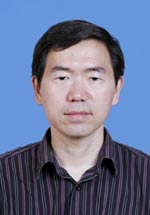|
 |
| 张明权 |
本期点评专家:张明权
参考译文:
Asian Games opening ceremony rehearsed for the first time
A comprehensive rehearsal for Guangzhou Asian Games was initiated before an audience of nearly 10 thousand on the small island of Haixinsha (an island in Guangzhou, where the opening and closing ceremonies of 2010 Asian Games will be held) under glistening light regimes. The spectacular, dynamic, and "creative (they say)" performance overwhelmed all the spectators.
The most expected of all are welcoming the flame and lighting the cauldron. At the first rehearsal, as the Olympic cauldron pedestal located right in the center of the stadium was being slowly lifted to its peak, sparks blazed away showing the digits of 2010 on 8 gigantic projection screens paired into 4 "sails". However, the cauldron pedestal was empty in the rehearsal, for the cauldron and how it will be lit are both strictly kept secret. Presumably, the cauldron will be lit aloft in the air, according to the audience present.
和写作比起来,翻译更需要精雕细琢,对于“天才”作家而言,下笔千言,文不加点,并非不可能的事情,然而译者所译的一词一句都是有来源的,不是译者可以妄加更改的,作家可以把一整篇文章推倒重来,而译者需要的更多的是“打磨”的功夫。当然,考虑到汉译英的特点,由于语言基本功不扎实,一些初学者的译文也真需要推倒重来,笔者经常要为一些老师翻译论文摘要,有的是带着自己的译稿来找我修改的,结果我经常需要全部重译。没有达到基本要求的译稿是无法“打磨”的,所以学习翻译的人必须切记,先把外语学好了再做翻译(不是翻译练习,练习是没关系的)不迟,急于求成反而事倍功半,说的就是这个道理。
下面就以“打磨”为中心,具体看一些词语和句子的翻译。首先,第一段文字中“看过彩排的现场观众都大赞"有创意”,这句话和第一句话有所重复,怎样才能巧妙的把二者结合起来呢?笔者选择了“跨句处理”的方法,把第一句话中的“惊艳、创意和动感”拿出来做第二句的主语,翻译成The spectacular, dynamic, and "creative (they say)" performance overwhelmed all the spectators。注意在creative一词上是有引号的,并在括号里注明了they say,从而说明这也是观众的用词。另外,对于第一句话中“绚丽灯光环绕下”的处理,笔者刻意选择了light regimes这个专业术语,回译成中文就是“光环境”的意思,这样可以弥补glistening一词对译“绚丽”上的一些不足。
在译题一中,“圣火”flame,“彩排”rehearsal,“惊艳”spectacular, “主火炬”Olympic cauldron等汉语词汇和英语词汇似乎不是一一对应的,汉语词汇负载了更多的感情色彩,而英语词汇则更客观,这里涉及我们此前多次分析过的问题。有网友慨叹,没有看过开幕式彩排,所以不知道“4面‘风帆’上的8块巨型投影屏”到底是什么样子的,这也是翻译中遇到的一个问题,就是一些专业的东西,包括前面说的“主火炬”,往往需要请教专业人员或者查找专业词典。风帆(sails)的创意很容易让我们想到迪拜的七星级酒店,而“投影屏”有点令人怀疑是“液晶屏”,不少网友省译为screen,也可能也是有此怀疑,但从技术上讲用投影屏一点问题没有,所以这里我们还是直译projection screen,在没有确凿证据前译者不能擅改原文。在整个翻译中,笔者参阅了相关报道,把上面提到的这句话翻译成了on 8 gigantic projection screens paired into 4 "sails"(“蓝咪咪”翻译成 8 projection screens on "sail-shaped" LED panels,笔者没有查到相关的资料):还有就是“受到严格保密的圣火也没有露面”,这里也涉及不少的翻译问题,因为保密的原因,彩排时的“主火炬塔”肯定是空的,所以笔者翻译为:the cauldron pedestal was empty in the rehearsal,而至于保密的内容,结合下文对圣火点燃方式的推测,综合翻译成the cauldron and how it will be lit are both strictly kept secret(我觉得火炬flame正在传递中,本身就是不可能进场的)。
PS: 通过仔细研究,我总结与奥运火炬有关的一些词,不当之处,还请专业人员指正。火炬或圣火(flame),圣火盆(cauldron),主火炬(cauldron),主火炬塔(cauldron pedestal)。媒体中报道的“胡锦涛在亚运火炬接力仪式上点燃主火炬”里的“主火炬”应该是指“圣火盆”,而“点燃主火炬塔”就是点燃主火炬塔上的主火炬(在英语中和圣火盆是同一个单词cauldron)。
参考译文: Beijing Pavilion to come home
Only ten days to go before the World Expo drops its curtain. People are seeking a last opportunity for a "carnival" (“蓝咪咪”的译文很好:Shanghai Expo is indulging in its last moment of joy). Despite strong appeals for an extension from the public, the World Expo is to conclude on October 31st as scheduled. Good news: the glamorous Beijing Pavilion will be packed home and open up in its home city to entertain local residents who failed to make it to the Shanghai World Expo.
According to an informed person, "Green Beijing" has been one of the themes for the pavilion of China's capital. In view of sustainable use, an unconventional welding technology was adopted immediately the pavilion was constructed.
世博会闭幕了,那么能不能说the World Expo draws its curtain呢?按照词典的解释to draw a curtain的意思是to cause a curtain to slide or move, either closing or unclosing,应该是可以的,笔者在网上也搜到了个别的例证,但大多数媒体在报道的时候还是选择了其它的表达方式,比如draw its curtain to a close, drop a curtain, lower a curtain, the curtain falls等,原因可能是draw a curtain同时也可以表示开幕。网友的翻译仅有一人使用了the curtain will be drew(过去分词应该是drawn)的表达方式。“延期”的翻译在这里基本上分为两种,extension或者postponement,extension指空间和时间上的延展,是对现存事物的改变,而postponement涉及的事情往往还没开始,需要延期举行,所以后者用在这里不合适。至于“网上网下”,可以采用二分法,翻译成netizens and non-netizens,或者省译为the public。
比较有意思的是“衣锦还乡”这个汉语成语,网友的翻译各有千秋,比如make a triumphant homecoming等,这也是“蓝咪咪”网友的翻译,值得一提的,该网友整体上翻译的很好,参考译文中failed to make it to spl.和 sustainable use也是对该译文的借鉴。
特别值得注意的是,“据记者了解”中的记者到底是指谁,经查网络可以发现,这是北京晨报记者朱烁的新闻稿,这里的记者应该指其本人,因为新闻通常标榜客观,所以不说“我”或“本人”。在电视媒体中,由播音员对新闻转述,所以其中提到的记者会有不同。因此,这里不能翻译成according to the journalist或reporter,有两种处理方式,一是用被动语态,the reporter is informed,二是干脆不提记者,而是换成信息的提供者,according to an informed person。
参考译文
"Hoarders" swing into action as prices rise
When news come that prices are going up for daily necessities, such as cloth, toilet paper, milk powder, sugar and cooking oil, smart guys determine to get the upper hand at everything before the dice is cast. The day before yesterday, the reporter personally observed that in some supermarkets at Beijing, oil of some brands and sugar were sold out. Seeing through people's hoarding mentality, businessmen were passionately promoting economy size. Under the impulse to save money, young people as well as senior citizens loaded their shopping trolleys with white sugar, edible oil and rice. Surprisingly, the calculative youth even swung into faster action than their elders.
从“囤积者”到“囤囤族”,词语的发展总是走着一条求新、时尚的道路,然而当“囤囤族”向年轻人包抄过来的时候,原本的一丝幽默瞬间变成了苦涩,遇着涨价的时候,消费者自然萌生“囤积”心理,然而原本省钱的举动却成就了商家的利润。英语中有hoarder一词对应“囤囤族”,虽然不够时尚,却多了一份病态心理,请看例句:Pet hoarding is a disturbingly common mental illness that goes far beyond simply having a lot of cats: it is an actual disease that destroys homes and lives。实施上,用hoarder一词对应汉语“囤囤族”确实不够准确,“某某族”在汉语中现在是一个流行的构词成分,比如“工薪族wager earner/employees”、“蚁族(ant tribe)”、“啃老族(NEET group/boomerang child/kid)”、“追星族(fans)”等,有些词语直接对应于英语的词汇,有些则属于创新翻译,比如ant tribe。有网友用hoard group,hoarding group来翻译,反而使得语义更加狭窄,因为他们已被心理学用来指“囤积”强迫症患者。我们暂时确实还没有一个合适的对译词,但通过“引号”的使用,hoarder的意思扩大到包括汉语“囤囤族”应该没有问题。
“大包装商品”是一个商业词汇,应该翻译成economic size (products),不少网友翻译的不够专业,这也是翻译中经常遇到的一个问题—术语的使用问题,严复曾经说过:“一名之立,旬月踯躅。”孔子也说过:“名不正则言不顺。”在科技翻译中,则有专业人员把关审定全文的术语。
“不光是很多老年人的购物车里都有白糖、油和大米,省钱意识同样感染着年轻人。”这句需要综合调整翻译,我们看一个网友的译文:Not only can sugar, oil and rice be seen in elderly people's cart, the idea of money saving is also being shared among the youths. 这里实际上牵涉到汉语的“互文见义”的修辞手段,也就是说原句的意思是:“老年人和年轻人一样受到省钱意识的感染,同样在抢购日用品”,很多网友的翻译都是缺乏这样的一个综观(comprehensive perspective);再就是根据社会心理,年轻人本不会如此节省,所以笔者使用了young people as well as senior citizens来衔接二者。
本文仅代表作者本人观点,与本网立场无关。欢迎大家讨论学术问题,尊重他人,禁止人身攻击和发布一切违反国家现行法律法规的内容。
更多文章
英译汉 真的译成汉语了吗?
翻译中的增词与减词
翻译中的勘误与隐喻“取舍”
专家简介:
张明权,安徽省固镇县人,江苏大学外国语学院副教授,英语语言文学硕士,上外博士课程班进修。主要从事英语语言学和翻译学研究,在国内外学术期刊发表论文10余篇,出版译著两部,发表其他文章20余篇,有大量翻译实践经验,翻译总字数接近200万。Email: mqzhang@ujs.edu.cn。
(作者:张明权 中国日报网英语点津 编辑:Julie)